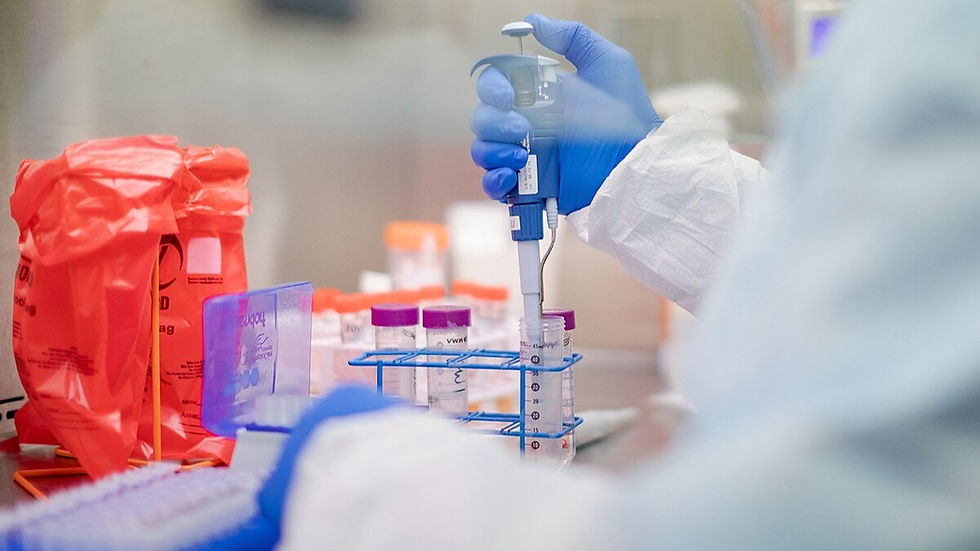The Yamanaka Factors and iPSC: Transforming the Future of Clinical Research
- Admin Landrich Group
- Oct 1
- 5 min read
This summer at the 2025 World Expo in Osaka, Japan, a pavilion titled “The Science of the Future” demonstrated tissue of a beating human heart created from skin cells. This was an application of induced pluripotent stem cells (also known as iPSCs). iPSCs are a technology at the heart of the revolution in biology that will transform medicine and scientific research in the coming decades.
This year’s expo, featuring exhibits from over 160 countries, is part of a tradition that originated in Victorian England. Hosted at a different global location every five years, the event was founded in 1851 to showcase inventions that transformed 19th-century society, such as locomotives, telegraphs, and surgical equipment.
The biotechnical applications of iPSCs, based on breakthroughs by Osaka native and Nobel laureate Shinya Yamanaka, are poised to shape major societal trends in the 21st century, ranging from the eradication of fatal diseases to increased fertility technology.

While the great inventions of the 19th century relied on core breakthroughs in our understanding of electromagnetism and thermodynamics. iPSCs rely on new insights into molecular biology, namely, the pluripotent state of a cell.
“Pluripotent” means many possibilities. In biology, it is used to describe cells that can develop into various specialized cells that compose a mature organism, such as blood, bone, brain, and muscle. Evolutionary scientists have long recognized that animal development begins with embryonic stem cells that differentiate during the blastocyst stage. This is the period when a fertilized egg grows into a ball of several hundred cells that will become the fetus.

Discovering a Mechanism for iPSC
Researchers in the 1980s and 1990s demonstrated the ability to manipulate embryonic stem cells to create the complex parts of an animal, including notable experiments such as the cloning of Dolly the Sheep. However, the dependence on embryonic stem cells posed multiple challenges, such as relative scarcity, technical complexity, and ethical considerations.
It wasn’t until Yamanaka and his team of genetic researchers at Kyoto University discovered four transcription factors – OCT3/4, SOX2, KLF4, and c-MYC, now known as the Yamanaka factors – that scientists had a way to reprogram ordinary adult cells into the initial pluripotent state of an embryonic cell. This discovery created a paradigm shift in multiple categories of medicine:
Disease Modeling. iPSCs can be generated to create patient-specific cell models of diseases. These models allow the study of specific disease mechanisms in human cells, including ones that are otherwise difficult or impossible to obtain from living patients, such as specific neurons or cardiac cells. This enables the study of diseases affecting tissues that are not easily sampled, greatly expanding diagnostic possibilities.
Drug Discovery and Screening. iPSC cells can be used to test the efficacy and toxicity of new drugs in human cell types, including organ damage and off-target effects, before testing in live patients.
Cell Therapy and Regenerative Medicine. iPSCs can be transformed into functional cells for repairing damaged tissues, such as the cardiomyocyte example showcased at the Osaka World Expo.
Gene Therapy. They are used in combination with tools like CRISPR/Cas9 to correct disease-related mutations and differentiate them into therapeutic cells for diseases like thalassemia, hemophilia, and cystic fibrosis in preclinical studies.
Organoids and 3D Tissue Models. iPSCs are used to create complex three-dimensional organoids (mini-organs) that mimic the structure and function of human tissues. These are particularly valuable for modeling diseases of the brain, liver, and other organs that are difficult to study in vivo.

Trials for Therapies, Devices, and Diagnostics
There are currently over 100 clinical studies using pluripotent stem cells (including iPSCs) targeting more than 40 diseases. Most new iPSC trials are interventional and company-led, with a strong focus in the Asia-Pacific region, especially Japan, but increasing activity is also observed in North America and Europe.
Japanese startups, such as Orizuru Therapeutics, Heartseed, and Cuorips, are working on regenerative medical products. These companies use iPSC-derived heart muscle and pancreatic cells for cardiovascular disease and type 1 diabetes. Other areas of clinical investigation include neurological diseases (e.g., Parkinson’s), ophthalmologic conditions (e.g., macular degeneration), and cartilage repair. Most iPSC-based trials are in early phases (Phase I/II), focusing on safety and initial efficacy.
The fields of in vitro diagnostics (IVD) and companion diagnostics have the potential for significant advantages by enabling more precise, patient-specific capabilities. A patient’s cells can be captured and differentiated into neurons, cardiomyocytes, and organ tissue with genetic and molecular characteristics unique to the individual. In a field like cardiology, for instance, iPSC heart tissue cells can help determine what a specific genetic mutation causes abnormal heart cell behavior to inform diagnosis.
Startups focused on iPSC-centered companion diagnostics have the potential to offer significant benefits with assays that better predict individual therapy, response, and toxicity for personalized treatment. ThinkCyte, with offices in Tokyo and Redwood City, is one example, focused on cytometry platforms for applications of iPSC-derived cells that enable high-throughput analysis for drug discovery, cell therapy, and clinical diagnostics.

Key Regulatory Challenges
This year, Japanese startups became the first globally to apply for commercial approval of iPSC-based therapies, with competitors in the US, China, and Europe certain to follow based on the potential and investments already announced in this field. Entrants into this field will contend with a patchwork of different regulatory standards across major global markets.
Japan offers a unique fast-track regulatory pathway that allows for conditional approval of regenerative medicine products, such as the iPSC-developed heart and pancreatic cells, after early-stage trials. Agencies in the US and EU offer their own versions of accelerated review under the FDA’s RMAT (Regenerative Medicine Advanced Therapy) designation and the EMA’s PRIME program. However, these agencies both require more pre-market evidence in comparison to Japan’s system. Japan also provides a longer buffer period for proving final efficacy than in the US and EU.
China uses a dual-track regulatory system for regenerative medicine and cell therapies, including iPSC-based products, which distinguishes it from Japan, the US, and the EU. It is also generally faster to grant conditional approvals for breakthrough products, and more likely than Japan and the EU to waive some domestic trials based on strong overseas data for urgent clinical needs.
As new technologies such as iPSCs outpace existing regulatory frameworks, it is important to develop regulatory strategies and engage National Competent Authorities (NCA) early in the product development process to develop pathways for market access. The Landrich Group offers Clinical Research, Quality, and Regulatory consulting to biotechnology firms to partner with them to bring safe and effective products to market that improve healthcare worldwide.




